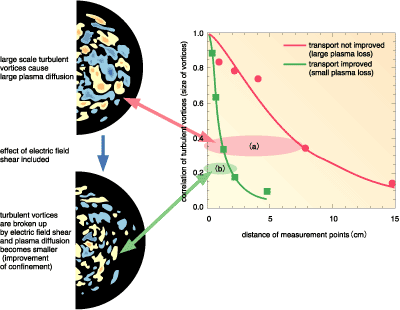Plasma confinement by a negative-sheared magnetic field has demonstrated excellent performance owing to the formation of an internal transport barrier (ITB) in the plasma that suppresses plasma particle and heat losses. In JT-60 there is a major effort to develop this confinement scheme as a potential prototype of a future steady-state tokamak reactor. Important issues are to investigate experimentally the physical relation between the characteristics of fluctuations in plasma densities and temperatures that are closely related to the plasma loss processes, and the characteristics of the ITB and its formation process.
We have measured for the first time the size of vortices of density fluctuations, and the correlation length using a new correlation reflectometer based on radar technique (Radio Detection and Ranging). The reflectometer consists of four channels of four different millimeter range wave frequencies, two of which operate at fixed frequencies and the other two channels are tunable, so that simultaneous measurements at four different spatial positions are possible. The correlation length of plasma density fluctuations along the plasma radius can be determined from the correlation between fixed and variable-frequency channels by changing appropriately the frequencies of the latter channel with a short time interval step in one tokamak discharge. Figure 2-5 shows a typical experimental result in which the correlation of fluctuation vortices on the size of turbulent fluctuations is plotted against measurement position. Case (b) in Fig. 2-5 shows the correlation of the size of vortices in the ITB region as indicated by the localization
of the measurement points, and the short correlation length corresponding to a good confinement having small particle and heat losses. This result qualitatively agrees with the theoretical prediction that describes the confinement is improved as the size of vortices becomes smaller, and further detailed studies will be carried out shortly. |
